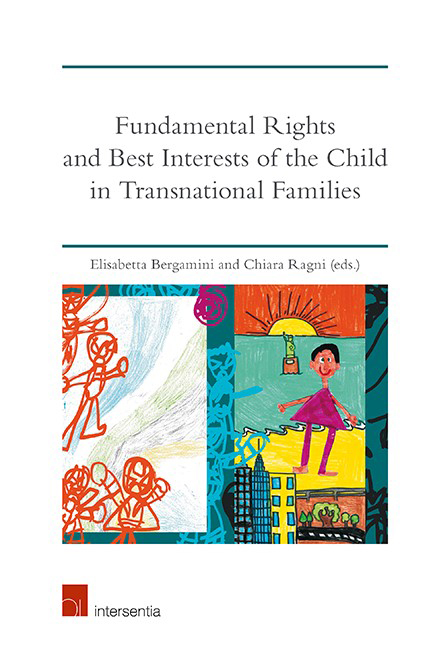Book contents
- Frontmatter
- Dedication
- Preface
- Acknowledgements
- Contents
- List of Cases
- List of Authors
- PART I THE IMPACT OF HUMAN RIGHTS AND OF THE BEST INTERESTS OF THE CHILD ON EU FREE MOVEMENT AND MIGRATION LAW
- PART II THE BEST INTERESTS OF THE CHILD AS A CONCERN OF HUMAN RIGHTS AND EUROPEAN PRIVATE INTERNATIONAL LAW
- The Place of Human Rights in the Private International Law of the Union in Family Matters
- The Best Interests of the Child Principle at the Intersection of Private International Law and Human Rights
- Recognition of a Foreign Status Filii: Pursuing the Best Interests Principle
- Surrogacy Arrangements and the Best Interests of the Child: The Case Law of the European Court of Human Rights
- Cross-Border Recognition of Adoption: Rethinking Private International Law from a Human Rights Perspective
- Protecting Children's Rights aft er Child Abduction: The Interaction of the CJEU and ECtHR in Interpreting Brussels II bis
- Cross-Border Parental Child Abduction in the EU: Is there Room for a Human Rights Exception?
- Impact of the Best Interests of the Child on the Brussels II ter Regulation
- Provisional Measures and the Best Interests of the Child in the Field of Parental Responsibility
- Index
- About the Editors
Surrogacy Arrangements and the Best Interests of the Child: The Case Law of the European Court of Human Rights
from PART II - THE BEST INTERESTS OF THE CHILD AS A CONCERN OF HUMAN RIGHTS AND EUROPEAN PRIVATE INTERNATIONAL LAW
Published online by Cambridge University Press: 12 November 2019
- Frontmatter
- Dedication
- Preface
- Acknowledgements
- Contents
- List of Cases
- List of Authors
- PART I THE IMPACT OF HUMAN RIGHTS AND OF THE BEST INTERESTS OF THE CHILD ON EU FREE MOVEMENT AND MIGRATION LAW
- PART II THE BEST INTERESTS OF THE CHILD AS A CONCERN OF HUMAN RIGHTS AND EUROPEAN PRIVATE INTERNATIONAL LAW
- The Place of Human Rights in the Private International Law of the Union in Family Matters
- The Best Interests of the Child Principle at the Intersection of Private International Law and Human Rights
- Recognition of a Foreign Status Filii: Pursuing the Best Interests Principle
- Surrogacy Arrangements and the Best Interests of the Child: The Case Law of the European Court of Human Rights
- Cross-Border Recognition of Adoption: Rethinking Private International Law from a Human Rights Perspective
- Protecting Children's Rights aft er Child Abduction: The Interaction of the CJEU and ECtHR in Interpreting Brussels II bis
- Cross-Border Parental Child Abduction in the EU: Is there Room for a Human Rights Exception?
- Impact of the Best Interests of the Child on the Brussels II ter Regulation
- Provisional Measures and the Best Interests of the Child in the Field of Parental Responsibility
- Index
- About the Editors
Summary
INTRODUCTION
The chapter begins with a comprehensive albeit brief overview of the case law of the European Court of Human Rights (ECtHR) on cross-border surrogacy (section 2). This is followed by a detailed analysis of the ECtHR's approach to the recognition of the legal parent-child relationship established abroad as a result of cross-border surrogacy (section 3). The focus of the chapter is on the problem of legal parenthood in the cross-border surrogacy context, with a particular emphasis on two key themes that arise in this context: the link between legal parentage and genetics, and the distinction between altruistic and commercial surrogacy. Throughout the analysis, the role of the best interests of the child principle in the specific context of the recognition of legal parentage established abroad through cross-border surrogacy is explored. The chapter concludes that, by prioritising the best interests of the individual child concerned, the ECtHR's recognition of legal parenthood in cross-border surrogacy undermines the principle of the best interests of the child generally.
CASE LAW OVERVIEW
Existing case law of the ECtHR on cross-border surrogacy can be placed into three broad categories, depending on the core legal issue that was dealt with in the particular case: (1) recognition of a legal parent-child relationship established through surrogacy abroad; (2) removal of the child from the intending parents; and (3) travel restrictions on children born through cross-border surrogacy.
RECOGNITION OF A LEGAL PARENT-CHILD RELATIONSHIP ESTABLISHED ABROAD
Mennesson v France and Labassee v. France
The ECtHR addressed the issue of the recognition of a parent-child relationship established abroad in the context of cross-border surrogacy for the first time in the joint cases of Mennesson v. France and Labassee v. France. The cases concerned the refusal to grant legal recognition in France to parent-child relationships that had been legally established in the United States between children born as a result of cross-border surrogacy and their intending parents. In both cases the intending parents were a married heterosexual couple. The children were conceived using the intending fathers ‘sperm and donor eggs. Court orders made in California and Minnesota respectively ruled that the intending parents were the children's legal parents.
- Type
- Chapter
- Information
- Publisher: IntersentiaPrint publication year: 2019
- 3
- Cited by

